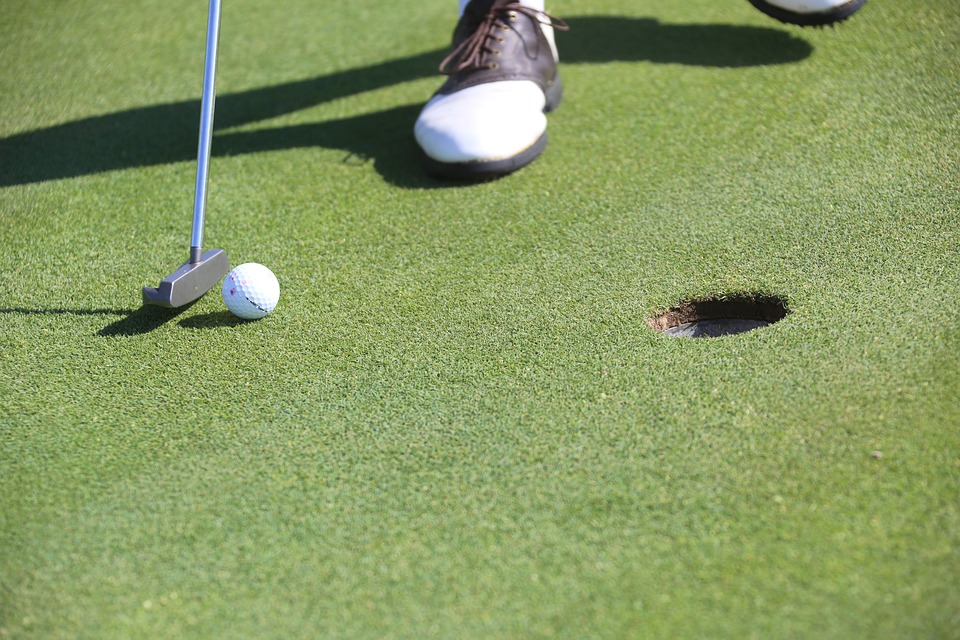I used to suck at putting. But these days I very rarely 3 putt, I make my fair share of 1 putts, and putting has become one of the strengths of my golf game.
Here are 8 simple, actionable putting tips that have made me a better putter. Follow them and those card killing 3 putts will soon be a thing of the past.
Jump To Section
1. Make EVERY putt a 1 footer
How often do you miss 1 foot putts? Not very often I’m guessing. You probably just walk up and bang the ball in without even bothering to set your stance correctly, or worry about alignment.
So…
Why not make every putt a 1 footer.
How?
Crouch down behind your ball to get a good view of the line. The closer you get to the ground, the easier it will be to see the true line.
Then pick a spot on the target line within 1 foot of your ball. It could be a discolored blade of grass, a bit of dirt, anything really. Just something that stands out.
Walk up to your ball and align your putter to the intermediate target.
Then all you have to do is roll the ball over the spot and you know it’s going to be bang on line.
And here’s the thing:
The line can look different when you’re standing addressing the ball than it did when you were behind it. You might feel that you’re aiming left or right of the hole. But you’re not. Trust the line you picked, then simply roll the ball over the spot.
Every putt efffectively becomes a 1 footer.
2. Outside of 8 feet distance/speed control is king
A 2 putt is fine. A 3 putt is a card killer.
If you use the intermediate target technique above for lining up your putt all you need to worry about is speed.
A putt outside of 8 feet isn’t going to drop every time. But what you want to do is make sure you get it within a 1 yard circle of the hole. In other words, gimme territory.
Which is why speed, and distance control is everything.
Over time you should get a pretty good feel for distance. But in the short term, a good way to practice is by hitting the practice green and pacing out different lengths.
Pace out 6 steps, then hit a dozen balls to the hole. Ingrain the feeling.
Pace out 10 steps, do the same. Get the feeling down.
Repeat at different lengths.
Some coaches recommend using a clock face technique, or different checkpoints for different distances (i.e. an 8 footer, take the putter back to your right knee).
But really, I would say that you just want to get the feel down. You want to clear your mind of mechanics when putting, as the minute you start to worry about your stroke, tension will creep in.
So get the feeling for each distance ingrained, then on the course pace out your putt from the flag. If it’s 6, 7, 8, 9, 10 steps, you know what to do. Trust your practice. Stick the ball in the dustbin lid.
3. View the line from the low side
On a reasonably flat green, you should always use tip 1 and find the line from behind your ball.
But when putting down a slope, you want to view the line from the low side.
The way our eyes work, when you look downhill, the line can be a little distorted. So crouch down behind the flag and look uphill back to your ball.
Then pick out your intermediate spot within a foot of your ball as before. And again, trust your line, and roll the ball over the spot you picked.
4. Try putting left hand low
I switched to left hand low putting about 2 years ago and it TOTALLY changed my game on the greens.
With my standard right hand low grip, my right arm would take over and I tended to pull the ball left, even on short putts. I got wristy.
The minute I switched to left hand low it was MUCH easier to roll the ball on my intended target line.
If you’re struggling with short putts, and feel you get yippy and wristy, then give a left hand low grip a try.
5. Inside 3 feet, keep the hole in your peripheral vision
This is something to experiment with if you struggle with short putts.
In fact, some golfers even go as far as looking at the hole rather than the ball on short putts.
But I recommend just keeping the hole in your peripheral vision. Your brain is good at reacting to a target, so keeping the hole in view can help make it easier to drain those tricky 3 footers.
6. Always miss on the high (pro) side
Us amateurs have a horrible habit of underestimating the break of a putt.
Putting guru Dave Pelz even goes as far to recommend that most amateurs should TRIPLE the break they see.
So if you’re not 100% sure on how the ball is going to break, then always err on the side of MORE break. When the ball is coming in from the high side, you’re effectively making the hole bigger. It’s got more of a chance to go in.
So make sure you’re missing your putts on the high side. You’ll soon find that more of them start to drop.
7. Never leave it short!
I’m sure you’ve heard the phrase “never up never in”. Well it’s true.
If the ball never reaches the hole, then it’s got absolutely ZERO chance of dropping. You’re not even giving yourself a chance of making the putt.
It’s nice to watch the ball die into the hole. But how many times have you watched a putt stop just one revolution away from a birdie. It’s soul destroying.
Ideally you want to hit every putt with enough pace that if it misses, it’s going to miss long by around a foot. You’re not going to miss the return putt and you’re giving it a chance to go in.
The only time I’d say it’s ok to be a little cautious is if you’re putting severely downhill. You don’t want it sliding 6 feet past. But with that being said, a 3 foot return putt uphill is going to be easier than a 3 foot putt down hill that you left short.
8. Practice your putting!
There, I said it.
You’re never going to become a better putter if you don’t practice.
Some studies have found that amateurs spend as little as 3% of their practice time on chipping and putting. Which is crazy when you consider that around 40% of your shots in a round will be on or around the green.
So: PRACTICE PUTTING.
The great thing is you don’t even need to go to your course or a short game practice area to do it. You can simply spend 10 minutes a day rolling balls on your carpet into a cup. And if you have a few dollars spare, there are a ton of great putting aids you can use at home.
There’s just no excuse not to practice putting.
So do it.
What’s Next?
Follow these 8 putting tips and I guarantee you’ll increase your confidence on the green, and shave strokes off your golf score.
And if you’re struggling with your chipping, then try this super simple chipping method that will help you get the ball close every time.
- Next: Best Golf Books For Beginners
- Previous: How To Chip A Golf Ball: Simple, Step-By-Step Method






